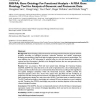115 search results - page 3 / 23 » The Complexity of List Ranking of Trees |
SPIRE
2010
Springer
13 years 7 months ago
2010
Springer
Several IR tasks rely, to achieve high efficiency, on a single pervasive data structure called the inverted index. This is a mapping from the terms in a text collection to the docu...
ICDT
2007
ACM
14 years 2 months ago
2007
ACM
Abstract. In many cases, users may want to consider incomplete answers to their queries. Often, however, there is an overwhelming number of such answers, even if subsumed answers a...
IBPRIA
2007
Springer
14 years 13 days ago
2007
Springer
Random forest is a collection (ensemble) of decision trees. It is a popular ensemble technique in pattern recognition. In this article, we apply random forest for cancer classifica...
BMCBI
2006
13 years 8 months ago
2006
Background: Gene Ontology (GO) characterizes and categorizes the functions of genes and their products according to biological processes, molecular functions and cellular componen...
CORR
2006
Springer
13 years 8 months ago
2006
Springer
Let S = s1, s2, s3, ..., sn be a given vector of n distinct real numbers. The rank of z R with respect to S is defined as the number of elements si S such that si z. We consider...

